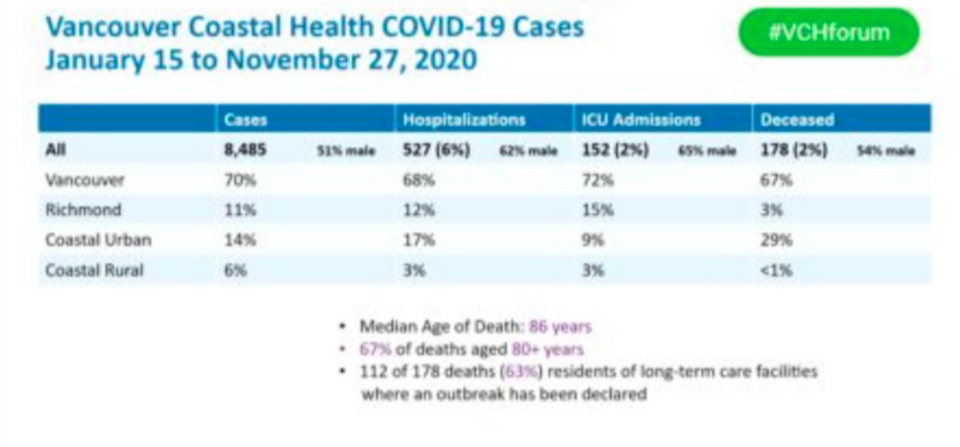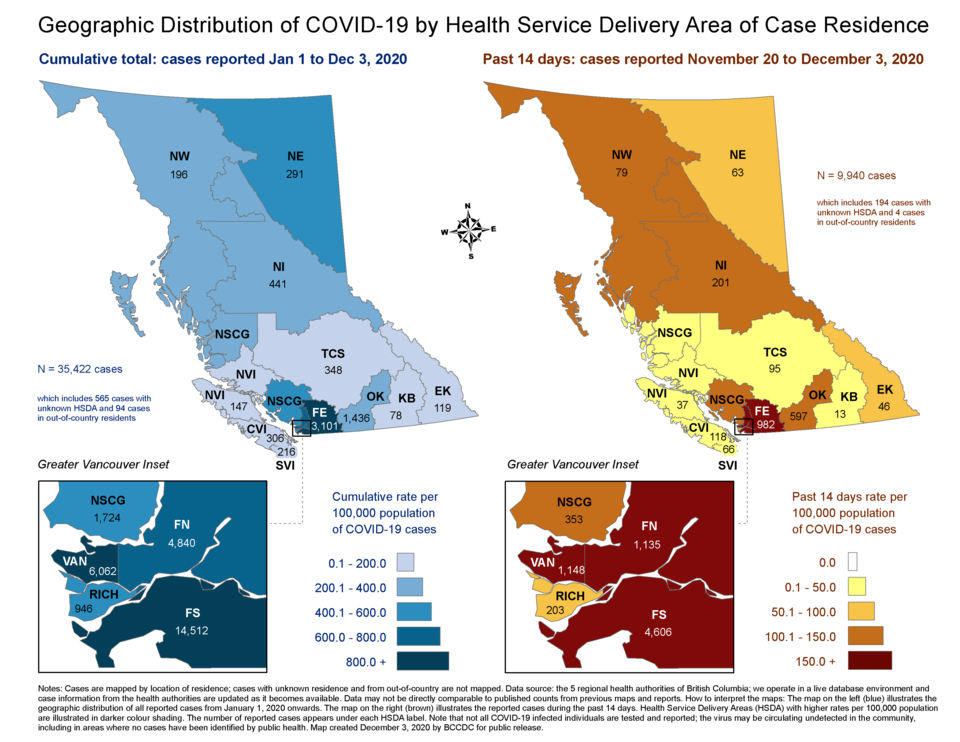COVID-19 cases on the North Shore have made up 14 per cent of the infections in the Vancouver Coastal Health region but a disproportionate number of deaths – 29 per cent – among those who have contracted the virus within VCH.
Those statistics were among a number presented by Dr. Patricia Daly, chief medical health officer for Vancouver Coastal Health, during an online presentation to the Vancouver Coastal Health board public meeting Nov. 30.
Of the 8,485 cases of COVID-19 reported in Vancouver Coastal Health between Jan. 15 and Nov. 27, 812 cases (10 per cent) were in North Vancouver and 311 cases (4 per cent) were in West Vancouver and Bowen Island.
Examined by population, however, West Vancouver has a higher rate of infection with a cumulative rate of just under 587 cases per 100,000, while the rate in North Vancouver, with a much larger population, is 549 per 100,000.
Infections in Vancouver make up the vast majority of COVID-19 cases in Vancouver Coast Health: 5,562 cases – or 70 per cent of the cases in the health region – according to Daly’s presentation. That gives Vancouver a cumulative incidence rate of just over 813 cases per 100,000.
Richmond had 847 cases, or 11 per cent of the total in VCH, with a much lower incidence rate per population of just under 403 cases per 100,000
Rates in most rural areas of the health region were much lower, with the Sunshine Coast reporting 48 cases total for the lowest incidence rate of 148.5 cases per 100,000 in the Vancouver Coastal Health region. Similarly, Powell River had 41 cases, giving it a population incidence rate of 194 per 100,000.
 An image showing the number of cases, hospitalizations and deaths in different parts of the Vancouver Coastal Health region. image VCH
An image showing the number of cases, hospitalizations and deaths in different parts of the Vancouver Coastal Health region. image VCHThe notable exception in the rural areas was the Sea-to-Sky Corridor, where there were 347 cases – more than in West Vancouver. Because of the relatively small population, that gave the area an incidence rate of over 846 cases per 100,000 – higher than Vancouver’s.
Daly said in her presentation the significant spike in the Sea-to-Sky numbers can be largely attributed to a recent outbreak among young workers in Whistler. About 200 of the Sea-to-Sky cases are in Whistler, said Daly.
Three popular Whistler hangouts – the Longhorn Saloon, Buffalo Bill’s Bar & Grill and Earl’s – were also listed as the locations of public COVID-19 exposures between Oct. 31 and the first week of November.
Vancouver residents accounted for 68 per cent of hospitalizations in the health region, as well as 72 per cent of ICU admissions and 67 per cent of deaths.
North Shore residents accounted for 17 per cent of the 527 hospitalizations (approximately 90 people) but fewer ICU admissions (approximately 14 people) at 9 per cent of the 152 people admitted to intensive care. Richmond had 12 per cent of the hospitalizations and 15 per cent of the ICU admissions in Vancouver Coastal Health.
North Shore residents, however, accounted for 29 per cent of the 178 deaths from COVID in VCH – approximately 52 people.
The higher proportion of deaths on the North Shore relative to the number of cases reflect the number of care home residents who died in North Vancouver during the first phase of the pandemic, as well as more recently, in addition to those who contracted COVID-19 and died during an outbreak at Lions Gate Hospital in the spring.
Vancouver residents made up 67 per cent of the deaths and Richmond residents made up about three per cent. People from rural areas accounted for less than three per cent of hospitalizations and ICU admissions and less than one per cent of deaths in VCH.
According to Daly’s presentation, 67 per cent of deaths in Vancouver Coastal Health have been among people over 80 and 112 of the 178 deaths have been residents of long-term care facilities where an outbreak has been declared.
Graphs showing the curve of the epidemic indicated the “second wave” of the pandemic has been far more pronounced in Vancouver than in other areas of the health region.
According to information released by B.C.’s Centre for Disease Control earlier this week, there were 353 new COVID-19 cases in the North Shore-Coast Garibaldi Health area (including the North Shore, Sea-to-Sky corridor, Sunshine Coast and Powell River) in the two weeks ending Dec. 3.
There were 1,148 new cases in Vancouver in that same time period and 203 new cases in Richmond.
In the south Fraser area – the centre of the current surge in cases – there were 4,606 cases in the past two weeks.



